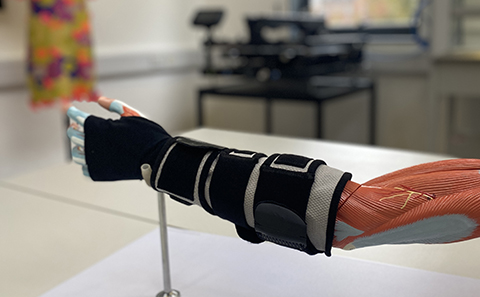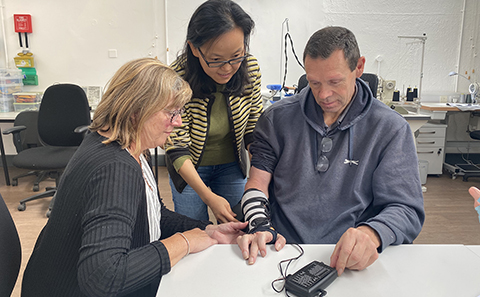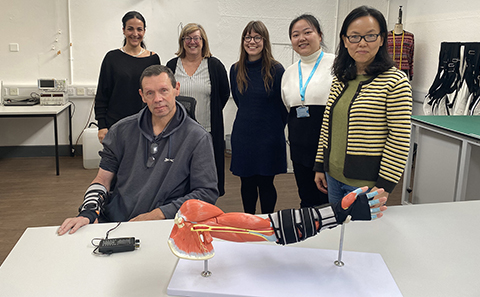But can it extend the fingers clenched due to spasticity? That's my problem.
Is it any better than all these other gloves?
Many gloves out there. Which is the best? Your doctor better know the answer.
FES-Robotic Glove (1)
Gyroscopic glove (1)
HERO Grip Glove (1)
music glove (1)
RAPAEL Smart Glove (5)
SaeboGlove (1)
VTS Glove (1)
EsoGlove (1)
The latest here:
A smart glove to improve stroke rehabilitation

An electronic glove that enables movement in the paralysed hand of stroke survivors – supporting their rehabilitation – has been invented by a team from the University of Southampton.
The glove has electrodes printed on the sleeve that make contact with the skin. The electrodes send electronic impulses to stimulate the nerves and muscles to produce an artificial movement. It enables stroke survivors to achieve movement in their weak side, helping them to regain muscle strength and function.
The glove has been designed and made by Kai Yang, Professor of E-textiles in Healthcare, and her team based at the university’s Winchester School of Art.
Professor Yang explained: “I wanted to develop something easy for
stroke survivors to use at home. People who have suffered a stroke get
fatigued easily, so engaging in long rehabilitation sessions is very
challenging. This glove enables them to work on their rehab in small
blocks of time when it suits them. With stroke rehabilitation, the more
you practice movement, the more you regain muscle strength and
mobility.”

The prototype glove has been developed and made at Winchester School of Art, using the school’s industrial knitting machines. The electrodes are printed inside the sleeve and connected to an electronic control unit, allowing the user to vary the level of stimulation as required.
Professor Yang has worked with Different Strokes Southampton, a charity run by stroke survivors for stroke survivors, to develop the glove.
Through the charity, she has worked with stroke survivor Dave Lea, from Chandler’s Ford. He suffered a major stroke in 2015, at the age of 54, that has left him largely paralysed on his right-hand side. The glove enables him to move his paralysed right hand. “It’s life changing,” he said. “It means I can move my hand – something I’ve been unable to do for eight years.”
Mr Lea’s wife, Sarah, added: “It was really emotional seeing Dave
test run the glove for the first time – it’s incredible that it enables
him to move his hand. It really could change the lives of stroke
survivors.”

Ranj Parmar, Group Coordinator at Different Strokes Southampton and a stroke survivor himself, added: “The benefits of the stroke rehabilitation sleeve are extremely impactful. It allows stroke survivors to be able to continue their rehab many weeks and months after their stroke. It enables a stroke survivor to open their affected hand and when performed repeatedly it should enable the opening and closing of the hand more easily.”
Professor Yang is now looking to refine the design of the prototype glove by working with more stroke survivors, and then conduct a home usability test with stroke survivors using the glove multiple times every day. Following this, she intends to seek regulatory approval and then work with a manufacturer to scale-up the production of the glove.
“We are delighted with the prototype and would like to see this become a product that’s available to all stroke survivors, to help improve their recovery and their quality of life,” she said.
Video at link.
No comments:
Post a Comment